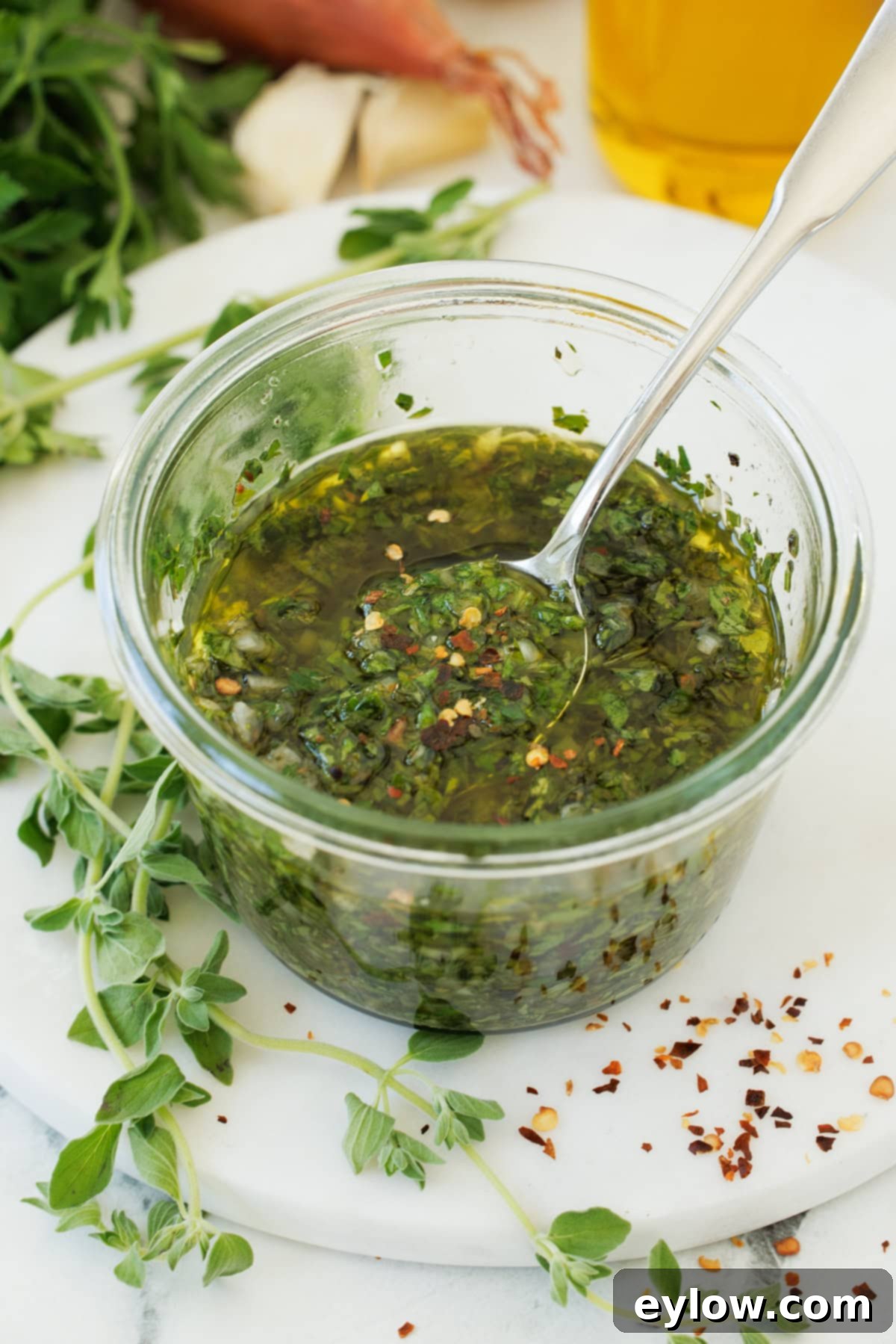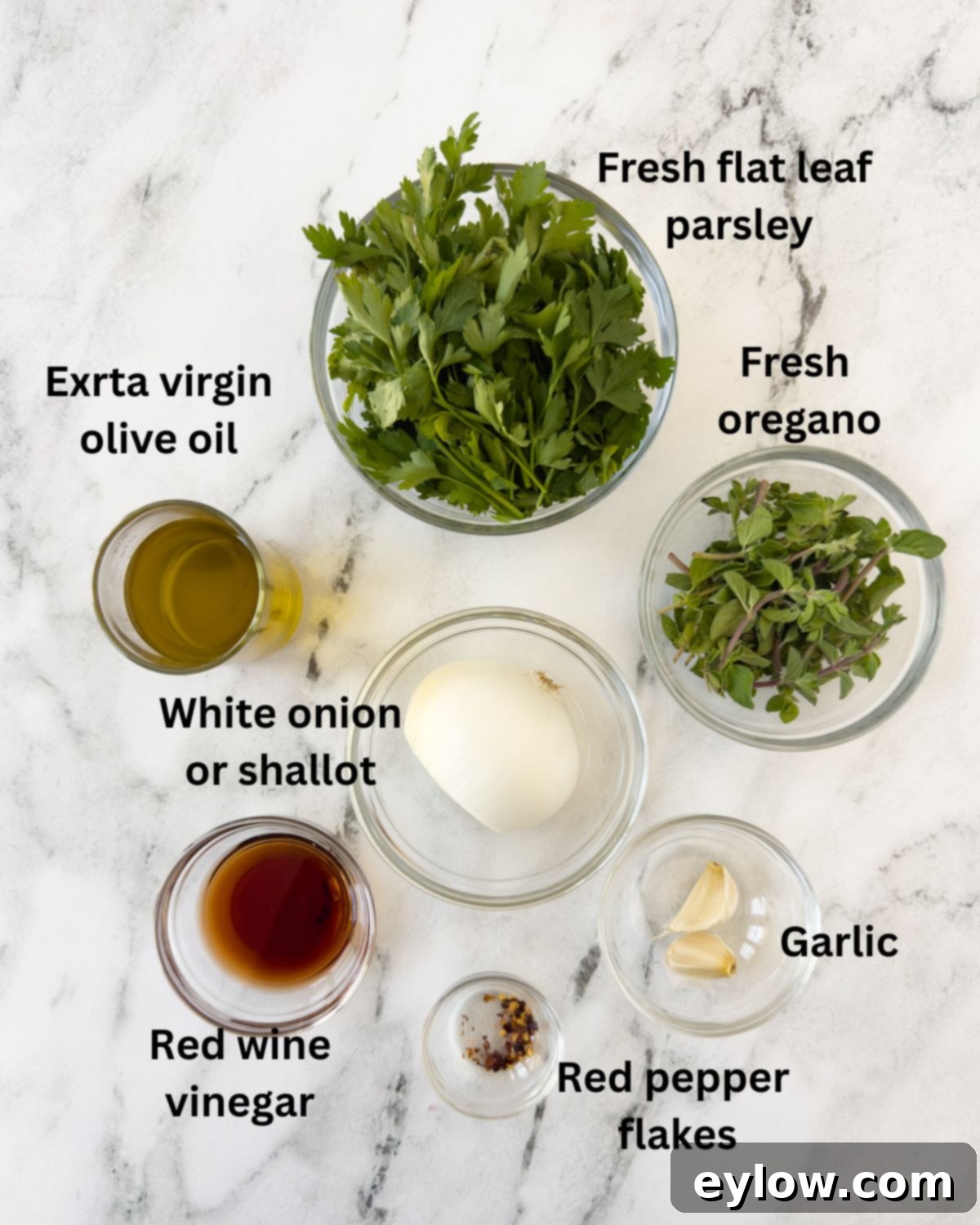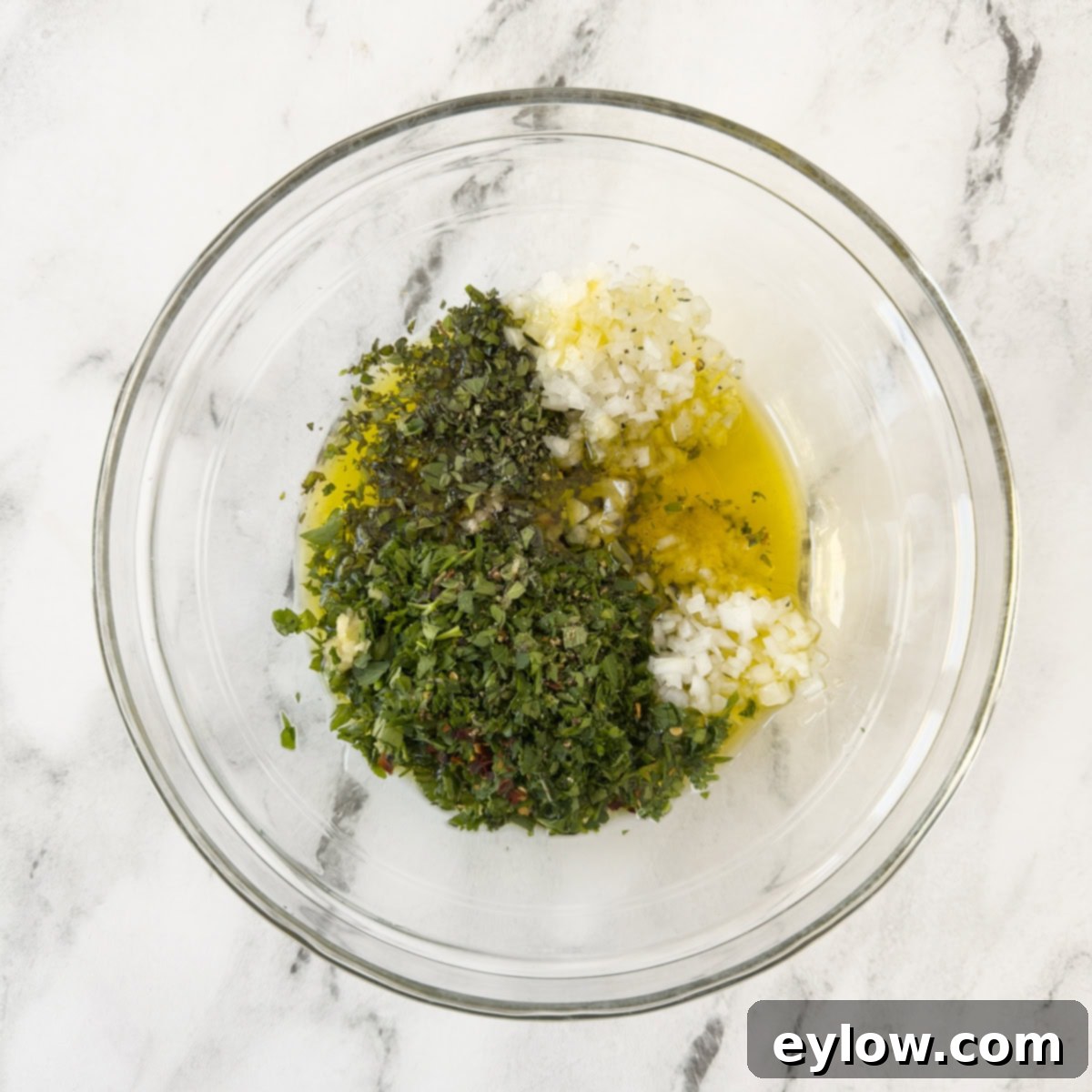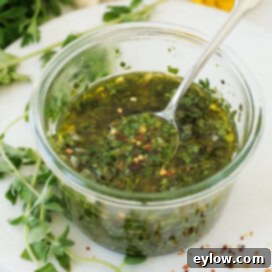Authentic Argentinian Chimichurri Sauce: Your Ultimate Guide to Fresh, Flavorful Perfection
If you’re seeking to elevate your culinary repertoire with a vibrant, intensely flavorful condiment that requires zero cooking, look no further than **authentic Argentinian Chimichurri sauce**. Known as *salsa chimichurri* in its homeland, this bold, no-cook sauce is a cornerstone of Argentine cuisine, brimming with fresh herbs, pungent garlic, rich olive oil, and a zesty kick from vinegar. It’s the kind of versatile, bright, and herby sauce that instantly transforms any dish, making everything taste more lively and exciting. From grilled steaks and chicken to seafood skewers and even scrambled eggs, chimichurri adds an unparalleled burst of flavor. Best of all, this incredible sauce comes together in mere minutes, proving that big flavor doesn’t have to mean big effort. I’ve refined this recipe, even getting the coveted “thumbs-up” for authenticity from my Argentine friends, so you can be confident you’re making the real deal.

Traditional chimichurri is more than just an herb-based sauce; it’s a culinary staple from Argentina that embodies the spirit of fresh, bold flavors. Imagine a sauce so irresistibly delicious, you’ll want to keep it perpetually stocked in your refrigerator, especially during the warmer months. With just a handful of simple ingredients and five minutes of prep, you can infuse your meals with a bright, herbaceous punch that elevates the entire plate. This easy fresh sauce also excels as a powerful chimichurri marinade, tenderizing and flavoring meats beautifully. It’s truly the perfect sauce for adding an authentic taste of summer to any gathering or weeknight meal.
Why You’ll Adore This Easy Chimichurri Recipe
Once you try homemade chimichurri, you’ll understand why it’s a beloved South American staple. Here are just a few reasons why this recipe will become a quick favorite:
- Explosive Flavor, Effortlessly Fast: Forget complicated cooking. This incredible sauce comes together by simply chopping, mixing, and serving in mere minutes. There’s no cooking required, making it ideal for busy weeknights or impromptu gatherings. The fresh, vibrant flavors are instantly impactful, bringing a restaurant-quality touch to your table with minimal fuss.
- Incredibly Versatile for Any Meal: While traditionally paired with grilled meats, chimichurri’s versatility knows no bounds. Use it to enhance grilled steak, chicken, pork, or seafood. Drizzle it over roasted vegetables, grain bowls, or even scrambled eggs for an instant flavor upgrade. It also doubles as an exceptional marinade, infusing your proteins with deep, herby goodness before they even hit the grill.
- Authenticity You Can Trust: This isn’t just any chimichurri recipe; it’s a tried-and-true version that has earned the seal of approval from my most discerning Argentine friends. You can confidently serve this vibrant sauce, knowing it captures the true essence of traditional Argentinian *salsa chimichurri*.
If you’re a fan of versatile summer sauces, you might also enjoy exploring this rich sun-dried tomato pesto for another burst of Mediterranean-inspired flavor.
What is Argentinian Chimichurri Sauce?
Chimichurri is a traditional herb-based condiment that hails from Argentina and Uruguay, serving as the quintessential accompaniment to *asado*, the South American barbecue. Unlike cooked sauces or thick pestos, chimichurri is a light, uncooked emulsion characterized by its fresh, bright, and tangy profile. It’s typically made with finely chopped fresh parsley, minced garlic, olive oil, oregano, and red wine vinegar. A touch of red pepper flakes often adds a subtle warmth without overpowering the delicate herb flavors.
The name “chimichurri” itself has a somewhat disputed origin, with popular theories ranging from an Anglicized corruption of “Jimmy’s Curry” (attributed to an Englishman named Jimmy who asked for “give me curry” at an *asado*) to a Basque word *tximitxurri*, meaning “a mixture of several things.” Regardless of its etymology, its cultural significance in Argentina is undeniable. It’s more than just a sauce; it’s an integral part of the dining experience, cutting through the richness of grilled meats with its fresh acidity and herbaceous notes. While there are regional variations and personal touches, the core components remain consistent, ensuring that familiar, delightful flavor no matter where you enjoy it.
Essential Ingredients for Perfect Chimichurri Sauce

Crafting exceptional chimichurri relies on a few high-quality, fresh ingredients. Here’s a closer look at each component:
- Fresh Flat-Leaf Parsley: This vibrant herb forms the backbone of traditional chimichurri. Its clean, slightly peppery, and fresh flavor is absolutely essential. Always opt for flat-leaf (Italian) parsley over curly parsley, as it offers a more robust flavor and a better texture when finely chopped. Ensure your parsley is thoroughly washed and dried before chopping to prevent a watery sauce.
- Fresh Oregano: Earthy, slightly peppery, and aromatic, fresh oregano adds a crucial layer of depth and balance to the sauce. While dried oregano can be used in a pinch, fresh is highly recommended for its brighter, more nuanced flavor that truly distinguishes authentic chimichurri.
- Extra Virgin Olive Oil: As a key emulsifier and flavor carrier, a good quality extra virgin olive oil is paramount. Its rich, smooth texture binds the herbs and spices together, creating a luxurious mouthfeel. Choose a good-quality, flavorful olive oil – it makes a noticeable difference in the final taste of your chimichurri.
- Garlic: Bold, pungent, and aromatic, fresh garlic cloves are absolutely essential for that characteristic punchy flavor. Finely minced or grated garlic (using a microplane for an almost paste-like consistency) integrates seamlessly into the sauce, ensuring every spoonful is packed with flavor.
- Vinegar (Red Wine Vinegar or Apple Cider Vinegar): This is where the tangy kick comes from! Red wine vinegar is traditionally used for its sharp, bright acidity that cuts through the richness of meats and refreshes the palate. If you prefer a slightly softer, fruitier acidity, apple cider vinegar works beautifully as well. White vinegar can also be a substitute, but red wine vinegar, like an organic cabernet red wine vinegar, delivers the most authentic profile.
- Onion: Finely chopped white onion provides a traditional sharp, fresh bite that complements the herbs and garlic. Its crisp texture and pungent flavor add another dimension to the sauce, contributing to its overall complexity.
- Red Pepper Flakes: These dried chili flakes introduce a gentle heat and a touch of warmth. The amount is easily adjustable to your preference; use less for a milder sauce, or add more for an extra spicy kick.
- Kosher Salt and Freshly Ground Black Pepper: These fundamental seasonings are crucial for balancing and enhancing all the other flavors. Seasoning to taste is key to achieving the perfect chimichurri.
For precise measurements and the complete method, please refer to the detailed recipe card below.
Speaking of fantastic summer marinades, consider whipping up a batch of this blender lemon chicken marinade to prepare some truly delicious grilled chicken breasts.
Chimichurri Substitutions and Creative Variations
While the classic chimichurri recipe is perfect as is, it’s also incredibly adaptable. Feel free to experiment with these substitutions and variations to tailor the sauce to your personal taste or what you have on hand:
- Herb Variations: Flat-leaf parsley and fresh oregano are the traditional stars. However, you can replace a portion of the parsley with fresh cilantro for an earthier, more Latin-inspired flavor. A small amount of fresh mint can also be added for a bright, cooling note, especially lovely with lamb or fish. Fresh marjoram can be used as a substitute for oregano or added in small quantities for a slightly sweeter, more floral aroma.
- Onion Alternatives: For a milder onion flavor, finely chopped shallots make an excellent substitute for white onion. They offer a delicate sweetness that can be particularly appealing. You could also use red onion for a slightly sharper flavor and a beautiful color contrast.
- Adjusting Texture: Traditionally, chimichurri is hand-chopped to achieve a rustic, somewhat chunky texture. If you’re short on time, you can certainly use a food processor. Just be cautious not to over-blend; pulse everything briefly until finely chopped, avoiding a smooth puree. Over-blending can make the sauce pasty and diminish the vibrant freshness.
- Balancing Tanginess: If your chimichurri tastes a bit too sharp or tangy for your palate, a small pinch of sugar or honey can work wonders to mellow the acidity and create a more balanced flavor profile without making it sweet.
- Increasing the Heat: For those who love a spicy kick, simply increase the amount of red pepper flakes. You can also add fresh minced chili peppers such as jalapeño, serrano, or even a aji for a more authentic Argentine heat. Remember to remove seeds for less heat, or leave them in for maximum spice.
- Alternative Acidity: While red wine vinegar is traditional, fresh lemon juice can be swapped in for a brighter, citrusy note. This works particularly well when pairing chimichurri with seafood.
We can never have too many amazing sauce recipes, can we? After mastering chimichurri, try this vibrant orange, creamy Hungarian paprika sauce, which is also fantastic over grilled meats, chicken, and a variety of other dishes.
Simple Step-by-Step Instructions
Making this incredible Argentinian chimichurri sauce is surprisingly easy. Follow these simple steps for a burst of fresh flavor:

- Prepare the Herbs and Aromatics: Begin by finely chopping your fresh flat-leaf parsley and oregano. It’s important to chop them as finely as possible for the best texture and flavor distribution. Then, finely chop the white onion and mince the garlic cloves (or zest them with a microplane for a smoother texture). Combine all these aromatic ingredients in a medium-sized mixing bowl.

- Combine and Season: To the bowl with your chopped herbs, onion, and garlic, add the extra virgin olive oil and red wine vinegar. Stir everything together until well combined. Next, add the kosher salt, freshly ground black pepper, and red pepper flakes. Give it another good stir to ensure all the seasonings are evenly distributed throughout the sauce.

Rest for Flavor Development: Once mixed, allow the chimichurri sauce to sit for at least 10-15 minutes before serving. This brief resting period allows the flavors to meld and deepen, resulting in a more harmonious and delicious sauce. You can also refrigerate it for a few hours, or even overnight, to further enhance the flavor. Enjoy it fresh over the next few days for the best taste.
Unleash the Flavor: Creative Ways to Use Chimichurri
Authentic Argentinian chimichurri sauce is renowned for its pairing with grilled steak, and it undeniably creates a magnificent combination (I especially love serving it with grilled flank steak and using it as a marinade). However, its vibrant flavor profile makes it incredibly versatile, enhancing a vast array of dishes beyond just red meat. For the most impactful flavor, always serve chimichurri at room temperature.
- Classic Pairing with Grilled Meats: Drizzle generously over grilled or roasted steak, chicken breasts, chicken thighs, pork chops, or lamb. It cuts through the richness and adds a fresh, herbaceous zest.
- Elevate Grilled Vegetables: Spoon it over roasted potatoes, carrots, corn on the cob, grilled zucchini, or asparagus for an instant burst of flavor. It’s a game-changer for simple vegetable sides.
- Transform Salads: Mix chimichurri into a simple white bean salad, a hearty pasta salad, or this refreshing 3-bean salad for an instant, vibrant summer side dish. It also makes a fantastic dressing for green salads.
- Brighten Breakfast and Brunch: A spoonful over scrambled eggs, fried eggs, or an omelet adds an unexpected and delicious twist to your morning meal.
- Delectable Dipping Sauce: Serve it as a fresh dipping sauce for crusty bread, pita bread, or even vegetable sticks. It’s an appetizer that always impresses.
- Enhance Cold Dishes: Dress this cold green bean, corn, and tomato salad with chimichurri for a big flavor impact that’s perfect for picnics and barbecues.
- Chimichurri Mayonnaise: Stir some into your favorite mayonnaise for a herbaceous, tangy spread that’s perfect for burgers, sandwiches, or as a dipping sauce for fries and onion rings.
- Seafood Sensation: It pairs beautifully with grilled shrimp, pan-seared scallops, baked salmon, or white fish, adding a fresh, zesty counterpoint to the seafood.
- Bonus Use – The Ultimate Marinade: Chimichurri makes a truly fantastic marinade for almost any protein: steak, chicken, pork, or shrimp. For best results, double the batch: use half of the fresh chimichurri to marinate your protein for at least 30 minutes (or up to 4 hours for deeper flavor), and reserve the other half to serve fresh as the table sauce. This ensures you get both marinated flavor and the bright, uncooked freshness.
For long-term storage, check out the freezing tips in the FAQ section below.
Chimichurri Recipe FAQs
For the absolute best flavor and vibrant color, chimichurri is ideal within 3 days of preparation. It remains safe to consume for a few days longer, but you might notice the fresh herbs starting to darken, and the overall flavor may begin to fade over time. The good news is, it’s so incredibly easy and quick to make that whipping up a fresh batch whenever you need it is a breeze!
Traditional chimichurri has a mild warmth from the red pepper flakes, which adds a pleasant depth rather than intense heat. It is not typically overly spicy. The beauty of this recipe is that you have full control: you can easily adjust the amount of red pepper flakes to suit your personal heat preference, or even omit them entirely if you prefer a non-spicy version. For more heat, consider adding fresh minced chilies like jalapeño or serrano peppers.
Yes, chimichurri freezes exceptionally well, making it a perfect make-ahead condiment. There are two primary methods for freezing:
1. Freezing with Oil (Easiest Method): Simply portion the prepared chimichurri sauce into ice cube trays or small airtight containers. Once frozen solid, transfer the cubes to a freezer-safe bag or container to save space. When thawed, the oil may solidify and separate slightly, but a good stir will bring it back together. This method is convenient for grab-and-go portions.
2. Freezing Without Oil (To Preserve Color and Freshness): For those who prioritize maintaining the brightest color and freshest possible flavor, you can freeze just the chopped herb mixture (parsley, oregano, garlic, onion, and pepper flakes) *before* adding the olive oil and vinegar. After thawing, simply stir in the fresh olive oil and vinegar. This can help preserve the vibrant green hue and the crispness of the herbs a bit better, especially for visual presentation.
Both methods work effectively, and the robust flavors hold up nicely in the freezer. For optimal taste and quality, aim to use frozen chimichurri within 1-2 months.
More Delightful Fresh Summer Recipes
If you love the fresh, vibrant flavors of chimichurri, you’re sure to enjoy these other perfect-for-summer recipes:
- Easy Watermelon Basil Salad with Feta Cheese
- Burrata Caprese with Fresh Tomatoes
- Cold Green Bean Salad With Tomatoes and Corn
- Fresh Pineapple Mango Salsa Recipe
Did You Make This Authentic Chimichurri Sauce?
If you’ve ventured into making this vibrant Argentinian chimichurri sauce, I would absolutely love to hear from you! Please take a moment to add your comment below. Your feedback truly brightens my day, and I always enjoy reading about your culinary experiences. If you loved this recipe, please consider giving it a 5-star rating! Your ratings are incredibly helpful to other readers looking for delicious, authentic recipes like this one.
📖 Recipe

Argentinian Chimichurri Sauce
Sally Cameron
Pin Recipe
Equipment
-
Chef’s knife
-
Cutting board
Ingredients
- ½ cup packed finely chopped Italian parsley 1 bunch
- 1 ½ tablespoons finely chopped fresh oregano
- ½ cup extra virgin olive oil
- 2 large garlic cloves zested with a microplane or finely chopped
- 2 tablespoons red wine vinegar or apple cider vinegar
-
2-3
tablespoons finely chopped white onion or finely chopped shallot
- 2 pinches red pepper flakes
- ¼ teaspoon sea salt
- ⅛ teaspoon black pepper
Instructions
-
Add all finely chopped ingredients (parsley, oregano, onion, garlic), olive oil, and vinegar to a medium bowl. Stir them together until well combined. Season with salt, black pepper, and red pepper flakes. Taste the sauce and adjust seasonings as desired. For optional additions and variations, see the notes below.
Notes
- Traditional chimichurri recipes primarily feature parsley and oregano. However, you can personalize your sauce by replacing some of the parsley with fresh cilantro or marjoram, or by adding a small quantity of fresh mint for a brighter, more invigorating note.
- For an extra layer of heat and freshness, consider incorporating a finely minced red or green chili pepper, such as a jalapeño, fresno, or serrano pepper. Adjust the quantity to your preferred spice level.
- To add a subtle visual appeal and a delicate, floral aroma, stir in a few crushed pink peppercorns.
- If you prefer a milder onion flavor, finely chopped shallots make an excellent substitute for white onion.
- If your chimichurri turns out a bit too tangy, balance the acidity with a small pinch of sugar or honey.
